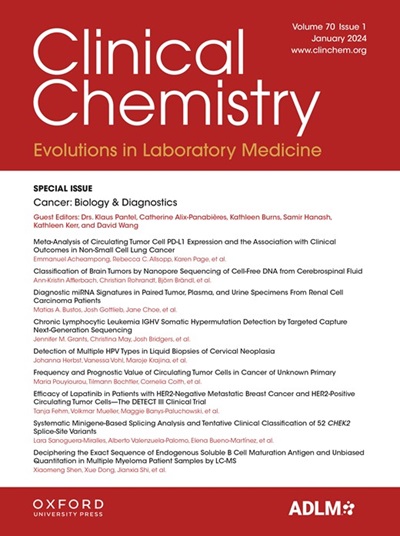B-036 Systematic Evaluation of Antibody-Antigen Interactions for Suitability in Immunoassays Using Parallel Microarray ELISA
IF 7.1
2区 医学
Q1 MEDICAL LABORATORY TECHNOLOGY
引用次数: 0
Abstract
Background A critical step in immunoassay development is the selection of the appropriate capture and detection antibodies. The use of suboptimal antibodies can drastically affect the quality of the final assay. Traditional selection methods involve a direct testing of potential antibodies in the final assay setting; a time-consuming and material-intensive exercise that is often too complex to test all possibilities. Alternatives, such as abstract K-on/K-off determinations via SPR or BLI can be costly and often show limited translatability to the ultimate assay format. Here, we describe a novel systematic approach to rapidly screen antibody-antigen interactions for key assay specifications and test for translatability of the findings. Methods Nanoliter volumes of potential capture antibodies were spotted onto the bottom of ELISA wells, generating a microarray of antibodies in each well (>11,000 spots per plate). For the analysis of capture antibody-antigen interactions, a titration series of biotinylated analyte in negative sample matrix was applied. Binding was visualized using strep-polyHRP, precipitating TMB and high resolution scanning of each ELISA well. Antibody pair performance was investigated using unlabeled analyte and biotinylated detection antibody options. Sensitivity, specificity, dynamic range, binding speed, binding strength and matrix compatibility were investigated using time courses, concentration ranges, dilutions, interferent spikes and pH/salt/detergent challenges. Signals were quantified to calculate and statistically compare each possible interaction. Results Antibody-antigen interactions were investigated via parallel microarray ELISA for two example immunoassays: the HBsAg and cTnI test. For both analytes, a panel of antibodies was screened revealing antibodies with diverse characteristics. Striking differences were observed depending on the sample matrix composition. Without optimization, antibodies could be identified showing dynamic assay ranges of 3-4 log orders. Time course experiments revealed high-affinity antibodies suitable for rapid diagnostic tests. For HBsAg, levels down to 0.01 IU/mL (∼40 pg/mL) could be reproducibly detected, which is well below the minimal requirement of 0.13 IU/mL. Reactivity against multiple virus serotypes could be confirmed. Interestingly, for the cTnI test, a strong synergistic effect was observed when specific monoclonal antibodies were combined in the capture mix, resulting in a 6-fold sensitivity enhancement compared to their separate performances. Finally, we show that the results obtained with the parallel microarray ELISA approach are highly translatable to the final assay format, ranging from bead-based dry-chemistry assays to chemiluminescent immunoassays. Conclusions The parallel microarray ELISA evaluation presents a robust and reliable method for identifying the best antibodies for an immunoassay. It allows for a systematic and quantitative screen of numerous antibody options within 1-2 weeks under real immunoassay conditions with minimal antibody amounts. This method has shown to be highly translatable and is customizable to accommodate required assay specifications.B-036 利用平行微阵列酶联免疫吸附法系统评估抗体-抗原相互作用在免疫测定中的适用性
背景 免疫测定开发的关键步骤是选择合适的捕获和检测抗体。使用不理想的抗体会严重影响最终检测的质量。传统的选择方法包括在最终检测设置中直接测试潜在的抗体;这是一项耗时耗材的工作,通常过于复杂,无法测试所有的可能性。其他替代方法,如通过 SPR 或 BLI 进行抽象的 K-on/K-off 测定,不仅成本高昂,而且对最终检测形式的可转化性往往有限。在此,我们介绍一种新颖的系统性方法,用于快速筛选抗体-抗原相互作用的关键检测指标,并测试结果的可转化性。方法 将纳升容量的潜在捕获抗体点在 ELISA 孔的底部,在每个孔中生成抗体微阵列(每板 11,000 个点)。为了分析捕获抗体与抗原的相互作用,在阴性样品基质中使用了生物素化分析物滴定系列。使用链式聚 HRP、沉淀 TMB 和高分辨率扫描每个 ELISA 孔来观察结合情况。使用未标记的分析物和生物素化的检测抗体选项研究了抗体配对的性能。利用时间历程、浓度范围、稀释度、干扰峰值和 pH 值/盐/洗涤剂挑战,对灵敏度、特异性、动态范围、结合速度、结合强度和基质兼容性进行了研究。对信号进行量化,以计算和统计比较每种可能的相互作用。结果 通过并行微阵列酶联免疫吸附法研究了抗体与抗原之间的相互作用,该方法适用于两种免疫测定:HBsAg 和 cTnI 检测。针对这两种分析物,筛选出了具有不同特征的抗体。根据样品基质成分的不同,可观察到惊人的差异。在未进行优化的情况下,可以确定抗体的动态检测范围为 3-4 个对数级。时间历程实验显示,高亲和力抗体适合快速诊断检测。对于 HBsAg,可重复检测到低至 0.01 IU/mL(40 pg/mL)的水平,远低于 0.13 IU/mL 的最低要求。对多种病毒血清型的反应性可以得到证实。有趣的是,在 cTnI 检测中,当特异性单克隆抗体结合到捕获混合液中时,可以观察到很强的协同效应,使灵敏度比单独使用时提高了 6 倍。最后,我们证明了平行微阵列酶联免疫吸附试验方法所获得的结果非常适用于最终的检测形式,从基于微珠的干化学检测到化学发光免疫测定。结论 平行微阵列酶联免疫吸附分析评估为确定免疫测定的最佳抗体提供了一种稳健可靠的方法。它允许在 1-2 周内,在实际免疫测定条件下,用最少的抗体量对众多抗体选项进行系统和定量筛选。该方法具有很强的可转化性,可根据所需检测规格进行定制。
本文章由计算机程序翻译,如有差异,请以英文原文为准。
求助全文
约1分钟内获得全文
求助全文
来源期刊

Clinical chemistry
医学-医学实验技术
CiteScore
11.30
自引率
4.30%
发文量
212
审稿时长
1.7 months
期刊介绍:
Clinical Chemistry is a peer-reviewed scientific journal that is the premier publication for the science and practice of clinical laboratory medicine. It was established in 1955 and is associated with the Association for Diagnostics & Laboratory Medicine (ADLM).
The journal focuses on laboratory diagnosis and management of patients, and has expanded to include other clinical laboratory disciplines such as genomics, hematology, microbiology, and toxicology. It also publishes articles relevant to clinical specialties including cardiology, endocrinology, gastroenterology, genetics, immunology, infectious diseases, maternal-fetal medicine, neurology, nutrition, oncology, and pediatrics.
In addition to original research, editorials, and reviews, Clinical Chemistry features recurring sections such as clinical case studies, perspectives, podcasts, and Q&A articles. It has the highest impact factor among journals of clinical chemistry, laboratory medicine, pathology, analytical chemistry, transfusion medicine, and clinical microbiology.
The journal is indexed in databases such as MEDLINE and Web of Science.
 求助内容:
求助内容: 应助结果提醒方式:
应助结果提醒方式:


